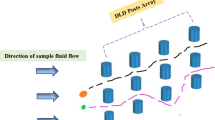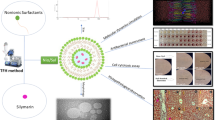Abstract
Oxygen tension is essential for cellular activities and plays an important role in clinical cancer treatment. In this paper, we constructed a single-layer microfluidic device with oxygen gradients to study oxygen-dependent cytotoxicity of anticancer drugs. Oxygen concentrations in the cell culture chamber are controlled by spatially confined oxygen-scavenging chemical reaction in the neighboring microfluidic channel. The groove-shaped structure of PDMS membrane is designed to increase its bonding ability to the bottom layer, which helps avoid the leakage of liquid while facilitating the exchange of gas between the cell culture chamber and the reaction channel. For demonstration, A549 cells were cultured in the microfluidic device and treated with tirapazamine (TPZ) or cisplatin under various oxygen contents. An increase in apoptosis of A549 cells was observed due to the hypoxia-induced cytotoxicity of TPZ, which provided evidence that anticancer efficiency of TPZ is influenced by oxygen tensions directly and have great promise in selectively killing tumor cells in hypoxic microenvironment. Conversely, cisplatin led to an increased cell death in the relatively higher oxygen contents because of the cell resistance in hypoxic conditions. The drug testing results showed that it is necessary to take the oxygen tensions in microenvironment into consideration to get a better standing in cellular responses after drug exposure. In summary, the developed microfluidic cell culture device displayed great cell compatibility and gradient controllability, and also provided a useful tool for drug-screening studies with meaningful oxygen tensions in various biomedical applications.






Similar content being viewed by others
References
Adler M, Polinkovsky M, Gutierrez E, Groisman A (2010) Generation of oxygen gradients with arbitrary shapes in a microfluidic device. Lab Chip 10:388–391
Ai XN, Liang QL, Luo MN, Zhang K, Pan JM, Luo GA (2012) Controlling gas/liquid exchange using microfluidics for real-time monitoring of flagellar length in living Chlamydomonas at the single-cell level. Lab Chip 12:4516–4522
Aquino-Parsons C, Luo C, Vikse CM, Olive PL (1999) Comparison between the comet assay and the oxygen microelectrode for measurement of tumor hypoxia. Radiother Oncol 51:179–185
Baguley BC (2010) Multiple drug resistance mechanisms in cancer. Mol Biotechnol 46:308–316
Brown JM, Wilson WR (2004) Exploiting tumor hypoxia in cancer treatment. Nat Rev Cancer 4:437–447
Carreau A, Hafny-Rahbi BE, Matejuk A, Grillon C, Kieda C (2011) Why is the partial oxygen pressure of human tissues a crucial parameter? Small molecules and hypoxia. J Cell Mol Med 15:1239–1253
Chang CW, Cheng YJ, Tu M, Chen YH, Peng CC, Liao WH, Tung YC (2014) A polydimethylsiloxane-polycarbonate hybrid microfluidic device capable of generating perpendicular chemical and oxygen gradients for cell culture studies. Lab Chip 14:3762–3772
Chen YA, King AD, Shih HC, Peng CC, Wu CY, Liao WH, Tung YC (2011) Generation of oxygen gradients in microfluidic devices for cell culture using spatially confined chemical reactions. Lab Chip 11:3626–3633
Durand RE (1993) The influence of microenvironmental factors during cancer therapy. In Vivo 8:691–702
Funamoto K, Zervantonakis IK, Liu Y, Ochs CJ, Kim C, Kamm RD (2012) A novel microfluidic platform for high-resolution imaging of a three-dimensional cell culture under a controlled hypoxic environment. Lab Chip 12:4855–4863
Graceber TG, Smanian CO, Jacks T, Housman DE, Koch CJ, Lowe SW, Giaccia AJ (1996) Hypoxia-mediated selection of cells with diminished apoptotic potential in solid tumors. Nature 379:88–91
Grasselli F, Basini G, Bussolati S, Bianco F (2005) Cobalt chloride, a hypoxia-mimicking agent, modulates redox status and functional parameters of cultured swine granulosa cells. Reprod Fertil Dev 17:715–720
Gray MD, Mann M, Nitiss JL, Hendershot LM (2005) Activation of the unfolded protein response is necessary and sufficient for reducing topoisomerase IIα protein levels and decreasing sensitivity to topoisomerase-targeted drugs. Mol Pharmacol 68:1699–1707
He TX, Liang QL, Zhang K, Mu X, Luo TT, Wang YM, Luo GA (2011) A modified microfluidic chip for fabrication of paclitaxel-loaded poly (l-lactic acid) microspheres. Microfluid Nanofluid 10:1289–1298
Junnotula V, Sarkar U, Sinha S, Gates KS (2008) Initiation of DNA strand cleavage by 1, 2, 4-benzotriazine 1, 4-dioxide antitumor agents: mechanistic insight from studies of 3-methyl-1, 2, 4-benzotriazine 1, 4-dioxide. J Am Chem Soc 131:1015–1024
Khanal G, Chung K, Solis-Wever X, Johnson B, Pappas D (2011) Ischemia/reperfusion injury of primary porcine cardiomyocytes in a low-shear microfluidic culture and analysis device. Analyst 136:3519–3526
Kondo A, Safaei R, Mishima M, Niedner H, Lin X, Howell SB (2001) Hypoxia-induced enrichment and mutagenesis of cells that have lost DNA mismatch repair. Cancer Res 61:7603–7607
Lam RH, Kim MC, Thorsen T (2009) Culturing aerobic and anaerobic bacteria and mammalian cells with a microfluidic differential oxygenator. Anal Chem 81:5918–5924
Ledoux S, Yang R, Friedlander G, Laouari D (2003) Glucose depletion enhances P-glycoprotein expression in hepatoma cells role of endoplasmic reticulum stress response. Cancer Res 63:7284–7290
Lo JF, Sinkala E, Eddington DT (2010) Oxygen gradients for open well cellular cultures via microfluidic substrates. Lab Chip 10:2394–2401
Mehta G, Mehta K, Sud D, Song JW, Bersano-Begey T, Futai N, Takayama S (2007) Quantitative measurement and control of oxygen levels in microfluidic poly (dimethylsiloxane) bioreactors during cell culture. Biomed Microdevices 9:123–134
Mu X, Liang QL, Hu P, Ren KN, Wang YM, Luo GA (2010) Selectively modified microfluidic chip for solvent extraction of Radix Salvia miltiorrhiza using three-phase laminar flow to provide double liquid–liquid interface area. Microfluid Nanofluid 9:365–373
Park J, Bansal T, Pinelis M, Maharbiz MM (2006) A microsystem for sensing and patterning oxidative microgradients during cell culture. Lab Chip 6:611–622
Patterson LH (1993) Rationale for the use of aliphatic N-oxides of cytotoxic anthraquinones as prodrug DNA binding agents: a new class of bioreductive agent. Cancer Metast Rev 12:119–134
Patterson LH (2002) Bioreductively activated antitumor N-oxides: the case of AQ4N, a unique approach to hypoxia-activated cancer chemotherapy. Drug Metab Rev 34:581–592
Polinkovsky M, Gutierrez E, Levchenko A, Groisman A (2009) Fine temporal control of the medium gas content and acidity and on-chip generation of series of oxygen concentrations for cell cultures. Lab Chip 9:1073–1084
Ren KN, Liang QL, Mu X, Luo GA, Wang YM (2009) Miniaturized high throughput detection system for capillary array electrophoresis on chip with integrated light emitting diode array as addressed ring-shaped light source. Lab Chip 9:733–736
Rockwell S, Kennedy KA, Sartorelli AC (1982) Mitomycin-C as a prototype bioreductive alkylating agent: in vitro studies of metabolism and cytotoxicity. Int J Radiat Oncol 8:753–755
Rockwell S, Dobrucki IT, Kim EY, Marrison ST, Vu VT (2009) Hypoxia and radiation therapy: past history, ongoing research, and future promise. Curr Mol Med 9:442–458
Skolimowski M, Nielsen MW, Emnéus J, Molin S, Taboryski R, Sternberg C, Geschke O (2010) Microfluidic dissolved oxygen gradient generator biochip as a useful tool in bacterial biofilm studies. Lab Chip 10:2162–2169
Snyder CM, Chandel NS (2009) Mitochondrial regulation of cell survival and death during low-oxygen conditions. Antioxid Redox Sign 11:2673–2683
Strese S, Fryknas M, Larsson R, Gullbo J (2013) Effects of hypoxia on human cancer cell line. BMC Cancer 13:331–342
Sud D, Mehta G, Mehta K, Linderman J, Takayama S, Mycek M (2006) Optical imaging in microfluidic bioreactors enables oxygen monitoring for continuous cell culture. J Biomed Opt 11:50504–50506
Tredan O, Galmarini CM, Patel K, Tannock IF (2007) Drug resistance and the solid tumor microenvironment. J Natl Cancer I 99:1441–1454
Vaupel P, Kallinowski F, Okunieff P (1989) Blood flow, oxygen and nutrient supply, and metabolic microenvironment of human tumors: a review. Cancer Res 49:6449–6465
Verbridge SS, Choi NW, Zheng Y, Brooks DJ, Stroock AD, Fischbach C (2010) Oxygen-controlled three-dimensional cultures to analyze tumor angiogenesis. Tissue Eng Part A 16:2133–2141
Yang K, Han S, Shin Y, Ko E, Kim J, Park KI, Cho SW (2013) A microfluidic array for quantitative analysis of human neural stem cell self-renewal and differentiation in three-dimensional hypoxic microenvironment. Biomaterials 34:6607–6614
Zhang K, Liang QL, Ma S, Mu X, Hu P, Wang YM, Luo GA (2009) On-chip manipulation of continuous picoliter-volume superparamagnetic droplets using a magnetic force. Lab Chip 9:2992–2999
Zhang K, Liang QL, Ma S, He TX, Ai XN, Hu P, Luo GA (2010) A gravity-actuated technique for flexible and portable microfluidic droplet manipulation. Microfluid Nanofluid 9:995–1001
Zhang K, Liang QL, Ai XN, Hu P, Wang YM, Luo GA (2011) Comprehensive two-dimensional manipulations of picoliter microfluidic droplets sampled from nanoliter samples. Anal Chem 83:8029–8034
Zhong W, Urayama P, Mycek MA (2003) Imaging fluorescence lifetime modulation of a ruthenium-based dye in living cells: the potential for oxygen sensing. J Phys D Appl Phys 36:1689–1695
Acknowledgments
We greatly appreciate the financial support from the Ministry of Science and Technology (2013ZX09507005), National Natural Science Foundation of China (21175080, 21235004, 21475071, 21275082), and Beijing Municipality (Z131100006513009).
Author information
Authors and Affiliations
Corresponding authors
Rights and permissions
About this article
Cite this article
Wang, Z., Liu, Z., Li, L. et al. Investigation into the hypoxia-dependent cytotoxicity of anticancer drugs under oxygen gradient in a microfluidic device. Microfluid Nanofluid 19, 1271–1279 (2015). https://doi.org/10.1007/s10404-015-1637-6
Received:
Accepted:
Published:
Issue Date:
DOI: https://doi.org/10.1007/s10404-015-1637-6




